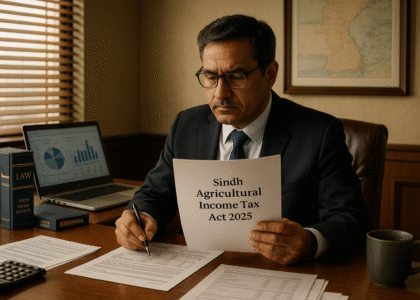📘 Introduction
The Finance Bill 2025 introduces a critical compliance-focused amendment to Section 22 of the Income Tax Ordinance, 2001, which deals with depreciation allowances on capital assets.
This amendment ties the allowability of depreciation to withholding tax compliance under sections 152 and 153, which cover tax deductions on payments to residents and non-residents, respectively.
📜 What Has Changed in Section 22?
🔹 Sub-section (1): New Proviso Added
A proviso has been added to sub-section (1) of Section 22, which states:
“Depreciation expense shall not be allowed for the amount paid for addition of capital assets if the applicable tax under sections 152 or 153 has not been deducted and deposited in the treasury.”
In simple terms:
If you purchase a capital asset (e.g., machinery, equipment, vehicles, etc.) and fail to deduct and deposit withholding tax from the payment to the supplier/vendor, you will not be allowed to claim depreciation on that portion of the asset’s cost.
Additionally, such non-compliant payments must not be added to the asset’s value for tax depreciation purposes.
🔹 Sub-section (2): Minor Punctuation Change
The amendment also replaces the colon at the end of sub-section (2) with a full stop. This is a technical correction with no substantive effect on interpretation.
💼 Legal Implications
This amendment effectively ensures that only properly documented and tax-compliant purchases qualify for depreciation allowance. Businesses must ensure:
Withholding tax is deducted from payments to vendors under Sections 152 or 153.
The deducted tax is deposited with FBR in a timely manner.
Capital asset additions are supported by tax-compliant invoices.
Failure to comply will result in disallowance of depreciation, which increases taxable income and tax liability.
🧠 Explanation of Key Sections
| Section | Purpose |
|---|---|
| Section 22 | Governs depreciation on capital assets for tax deduction |
| Section 152 | Requires deduction of tax on payments to non-residents |
| Section 153 | Requires deduction of tax on payments for goods/services/contracts to residents |
| Capital Asset | Includes plant, machinery, vehicles, equipment used in the business |
📊 Illustration
Example:
ABC Ltd. buys machinery worth PKR 5 million from a local supplier. They fail to deduct withholding tax under Section 153 and do not deposit any tax into the treasury.
Result:
ABC Ltd. cannot add the PKR 5 million to the asset base for depreciation.
Depreciation will not be allowed on that machinery until compliance is achieved.
Higher tax liability due to reduced allowable expenses.
✅ 20 Frequently Asked Questions (FAQs)
Q1: What is the purpose of this amendment in Section 22?
A: To enforce withholding tax compliance before allowing depreciation deductions.
Q2: Which taxes must be deducted for depreciation to be allowed?
A: Taxes under Section 152 (non-residents) or Section 153 (residents).
Q3: What happens if I deduct but do not deposit the tax?
A: Depreciation is still disallowed unless the tax is also deposited in the treasury.
Q4: Is this rule applicable to imported machinery?
A: Yes, if the payment is made to a non-resident, Section 152 applies.
Q5: Is depreciation permanently disallowed or deferred?
A: It is disallowed for all relevant tax years unless tax is deducted and deposited. Recovery may be possible in later years upon compliance.
Q6: How will FBR verify compliance?
A: Through audit of withholding statements, supplier records, and invoice reconciliations.
Q7: Will my asset still appear on the balance sheet?
A: Yes, but for tax purposes, the non-compliant portion won’t be depreciated.
Q8: What if I deal with an unregistered supplier?
A: You are still liable to deduct and deposit tax under Section 153.
Q9: What’s the impact on financial statements?
A: This affects only tax depreciation, not accounting depreciation.
Q10: Does this apply to previously purchased assets?
A: No, it applies to additions in relevant tax years post-enactment.
Q11: Is partial disallowance possible?
A: Yes. If part of the asset value is tax-compliant, only the non-compliant portion is disallowed.
Q12: What happens if tax is deducted at a wrong rate?
A: FBR may still consider it non-compliant if under-deducted or improperly filed.
Q13: Can I fix the error later?
A: If you later deduct and deposit the tax, depreciation may be allowed in future years, subject to audit.
Q14: Is this applicable to leased assets?
A: No, depreciation is typically claimed by the lessor, not lessee.
Q15: What if the seller is exempt from tax?
A: You may need to retain exemption certificate or obtain verification from FBR.
Q16: Will this increase audits or scrutiny?
A: Likely, especially for businesses acquiring high-value assets.
Q17: Is this applicable to all taxpayers?
A: Yes, all registered taxpayers claiming depreciation under Section 22.
Q18: Does this affect capital gains or just depreciation?
A: Only depreciation deduction under Section 22 is affected.
Q19: Does it apply to buildings and land?
A: Only to depreciable capital assets (not land), if acquired from a taxable person.
Q20: When does this come into effect?
A: Upon enactment of the Finance Act 2025, applicable to tax year 2025 and onward.
The amendment to Section 22 aligns with FBR’s broader agenda of enhancing tax compliance and closing leakages in the withholding regime. Businesses must:
Vet suppliers carefully
Ensure tax is withheld correctly
Deposit taxes timely to avoid disallowance
Non-compliance will not only reduce your expense base but may also trigger audits and penalties. Engage with a tax consultant to ensure you’re protected.






